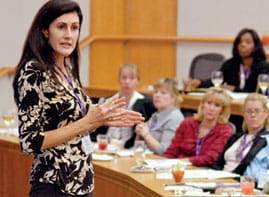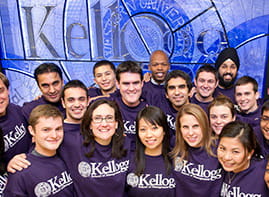Fidelity star tells Kellogg students how he turned his low-price strategy into a market-beating marvel
2/6/2008 - A portfolio manager needs to be good to beat the market, and even better to stay ahead of investment gurus like Warren Buffett, Berkshire Hathaway CEO.
Over nearly two decades, Kellogg graduate Joel Tillinghast’s intensive research and value perspective have enabled him to outperform the “Oracle of Omaha” while positively crushing the S&P 500. A dollar entrusted to Tillinghast’s Low-Priced Stock Fund in December 1989, when he launched the portfolio at Fidelity Investments, grew to nearly $16 by December 2006. That’s about $4 more than Buffett’s financial wizardry produced over the same time, and a whopping $12 more than what the S&P index generated.
On January 28, Kellogg School students had a chance to benefit directly from Tillinghast’s knowledge and experience during his visit to Professor
Robert Korajczyk’s Asset Management Practicum.
His advice for would-be market mavens? Understand a business before studying its numbers, since doing so helps determine why a company should be profitable and can “separate luck and temporary success from lasting success factors.” Tillinghast recommended digging deep when conducting this research, but not at the expense of the most obvious information sources.
“Read the annual report before you meet top management,” said Tillinghast, who is not above taking stacks of such documents to Boston Red Sox games, perusing the contents between innings. He told Kellogg students that the annual report is one important way that the firm’s leadership presents itself.
“Does management directly address tough business issues or identify growth opportunities? If they’re not very forthcoming in the report, that may be how they present themselves [in person].” Too many photos of the management team could indicate executives who are “egomaniacs,” he said. Conversely, no real indication of leadership could mean the firm is “a faceless company,” which presents its own set of problems.
Meeting with management before making an investment is critical, said the Kellogg graduate, particularly when looking at companies with smaller capitalization, firms Tillinghast considers “more vulnerable” to market volatility.
“These are small businesses, not built like GE, a battleship,” he said. “They can get tossed over in the wind.”
A disciple of Peter Lynch, legendary former manager of Fidelity’s Magellan Fund, Tillinghast said he prefers a low-turnover approach to his portfolio, which is composed almost entirely of stocks priced at $35 or under. This strategy requires Tillinghast to select investments carefully and be prepared to hold them for years — a practice that won’t fritter away investors’ money through transaction fees.
“I would totally lose my mind if I had to move investments as frequently as [Renaissance Technologies founder and CEO] Jim Simons,” said Tillinghast. “I tend to ease in and ease out [of investments].”
When does he know he’s held onto a company too long? “When they’re in Chapter 11,” Tillinghast deadpanned in response to a student question. More seriously, he noted that he will exit a business if he finds another that is operating better and more cheaply, or one that has what he considers more trustworthy management. “I do a side-by-side comparison.” He will also listen to feedback from competitors who claim they will soon overtake one of Tillinghast’s holdings. “If they say they are going to crush them, and it’s convincing, that will get me to sell.”
But getting to that point isn’t easy, he admitted.
Morningstar, the investment research company, has called Tillinghast “a diligent, bottom-up stock picker [who] pays little attention to market indices or macroeconomic trends,” but who nevertheless knows how to find undervalued equities that often can increase earnings even during inclement economic weather. Such qualities earned the Kellogg alumnus MarketWatch’s “Stockpicker of the Decade” honor in 2007.
Among the insights Tillinghast shared with Kellogg students were those acquired through his interactions with other top fund managers, including Lynch, Buffett and Neal Miller, former Fidelity New Millennium head:
* Friends, nonfinancial publications, plant and store visits and compulsive curiosity bring insights you don’t get from a CFO.
* React to trends not yet reflected in analytical models.
* Focus on companies that have very high returns on equity for decades.
* Look for barriers to entry that keep returns high.
* Network, but do your own research.
* Seek out information that is not obvious or well known.
Deliberative, and soft-spoken, Tillinghast can grow animated when the topic of questionable accounting practices or inadequate banking transparency arise. During his Kellogg visit, he voiced concerns about present value accounting — a formula that determines the current cash value of future assets — and said he believed there should be more disclosure of contingent liability, a potentially significant future risk that may not be indicated in a company’s balance sheet. Such lax frameworks, he told Kellogg students, played a part in the recent subprime lending crisis.
“I’m not a fan of present-value accounting, taking a gain on a security that you’ve not yet sold and converted to cash,” said Tillinghast. “They should have more rigorous standards for banks.” When his portfolio contained more financial institutions, he said that he favored “plain vanilla banks who knew their local markets very well.”
This perspective, in part, was formed during Tillinghast’s Kellogg School education. He told students that among his more memorable courses were marketing classes with Professor
Philip Kotler and an investment banking class taught by Professor John Roberson. He also cited a course taught by Professor Lawrence Lavengood on business and its environment.
“Investment ties together a lot of business aspects,” said Tillinghast. “You shouldn’t just do finance, though that’s obviously helpful, but so are these other courses.”
Professor Korajczyk called Tillinghast’s track record “amazing,” particularly given his ability to continue to deliver results with a fund that is huge relative to the amount originally invested in it.
Said Korajczyk, “His approach is very Kellogg-like, in the sense that he believes that good portfolio managers need to understand the whole business and competitive environment of the firm — strategy, marketing, managerial culture, in addition to being able to dissect the financial statements."






